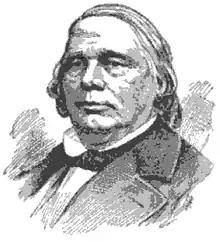Samuel Vaughan Merrick
Samuel Vaughan Merrick (1801–1870) was a 19th-century American manufacturer, and the first president of the Pennsylvania Railroad.
Samuel Vaughan Merrick | |
|---|---|
 | |
| Born | May 4, 1801 Hallowell, Maine |
| Died | August 18, 1870 (aged 69) Philadelphia, Pennsylvania |
| Occupation | Businessman |
| Spouse |
Sarah Thomas (m. 1823) |
| Children | 1 |
| Signature | |
Biography

Born near Hallowell, Maine, on May 4, 1801,[1] Merrick left school 1816 and moved to Philadelphia, where he worked for his merchant uncle John Vaughan.[1] He subsequently studied engineering, and in 1824 founded, with scientist William Keating, The Franklin Institute of the State of Pennsylvania for the Promotion of the Mechanic Arts, of which he was President from 1832 until 1854.[1] He also established the firm of Merrick and Agnew, which manufactured fire engines.[2]
He married Sarah Thomas on December 25, 1823 and they had one son.[3]
In 1836, Merrick established the Southwark Iron Foundry,[1] which became one of the most advanced manufacturing plants of its kind in this country. Operated by the firm of Merrick & Towne (later renamed Merrick & Sons), the foundry built the engines for the USS Mississippi.[2]
Merrick took a deep interest in public affairs and was instrumental to the introduction of illuminating gas into Philadelphia, being the chairman of a Committee of the Common Council that reported on the benefits of gaslighting. He also served as the first president of the Pennsylvania Railroad, which he had advocated as a means to connect Philadelphia to the west,[2][4] and was also president of the Sunbury and Erie Railroad[5] (later part of the PRR) and the Catawissa Railroad (later part of the Reading Railroad). Merrick was a member of the American Philosophical Society from 1833 until his death.[3]
Merrick maintained a residence in Haddon Township, New Jersey.[6] He died in Philadelphia on August 18, 1870.[3]
Footnotes
- Burgess & Kennedy (1949), p. 44.
- Goodwin (1870).
- The National Cyclopaedia of American Biography. Vol. XIII. James T. White & Company. 1906. pp. 333–334. Retrieved August 21, 2020 – via Google Books.
- Burgess & Kennedy (1949), p. 43.
- Churella (2013), p. 229.
- White-Grear, Sandra. "The Whitall-Van Sciver House" (PDF). Haddon Township Historical Society. Archived from the original (PDF) on March 21, 2012. Retrieved March 24, 2011.
References
- Burgess, George H.; Kennedy, Miles C. (1949). Centennial History of The Pennsylvania Railroad Company. Philadelphia: Pennsylvania Railroad Co. OCLC 499299.
- Churella, Albert J. (2013). The Pennsylvania Railroad: Volume I, Building an Empire, 1846–1917. Philadelphia: University of Pennsylvania Press. ISBN 978-0-8122-4348-2. OCLC 759594295.
- Goodwin, Daniel R. (December 16, 1870). "Obituary Notice of Samuel Vaughan Merrick, Esq". Proceedings of the American Philosophical Society. 11: 584–596. Retrieved August 5, 2016.
- Pennsylvania Biographical Dictionary. North American Book Dist LLC. January 1999. p. 150. ISBN 978-0-403-09950-4. Retrieved May 18, 2013.